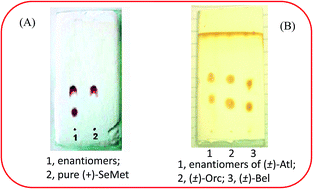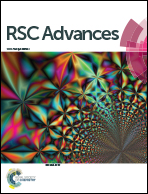Resolution of enantiomers with both achiral phases in chromatography: conceptual challenge
Abstract
A new practical approach has been adopted for the resolution (from racemic and non-racemic mixtures) of DL-selenomethionine using achiral phase chromatography supplemented with (−)-quinine as a chiral inducing reagent (CIR) and for the resolution of three racemic β-blockers (orciprenaline, betaxolol and atenolol) using L-Glutamic acid as a CIR. These analytes were pre-mixed with CIR and were applied to plain silica gel plates. The chromatograms were developed with the mobile phase having no chiral additive. Investigations were carried out by varying the pH, temperature and ratio of CIR to analytes. Native enantiomers were isolated and the detection limit for each enantiomer of SeMet was found to be 0.18 μg mL−1 and for enantiomers of the β-blockers it was found to be in the range of 1.2–1.8 μg mL−1. Optimized structures of transient diastereomers based on density functional theory using the Gaussian 09 Rev. A.02 program and hybrid density functional B3LYP with 6-31G* basis set have been developed. The separation mechanism has also been explained.


 Please wait while we load your content...
Please wait while we load your content...